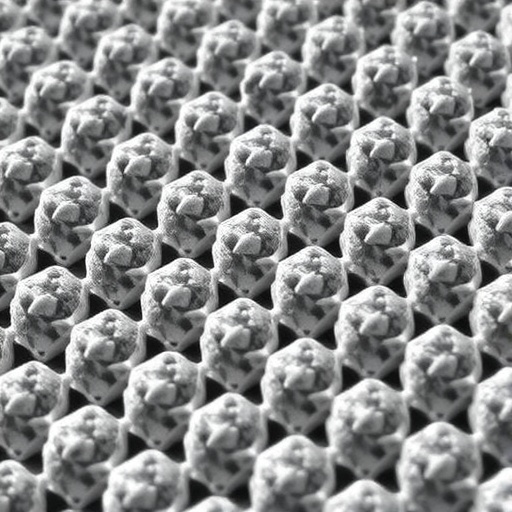In the ongoing pursuit to enhance the efficiency and performance of lithium-ion batteries, researchers are increasingly focused on innovation in cathode materials. One of the latest breakthroughs in this area comes from a team led by Lu, J., Wang, S., and Mu, M., who have developed an exciting new cathode material that holds promise for high-rate lithium storage. This novel cathode comprises interlayer-expanded Sn-doped V2O5, synthesized using a unique Metal-Organic Framework (MOF) assisted approach. This innovative synthesis method marks a significant departure from traditional techniques, potentially allowing for improvements in battery performance that could meet the growing demands of modern technology.
The transition towards electric vehicles and renewable energy storage systems has created an urgent need for advanced battery systems that not only provide high energy density but also exhibit fast charge and discharge capabilities. Existing cathode materials have limitations in achieving the desired balance between these two essential battery characteristics. The study conducted by Lu and colleagues presents compelling evidence that interlayer-expanded Sn-doped V2O5 can overcome some of these barriers, ultimately facilitating a performance leap in lithium-ion technologies.
Central to the research is the incorporation of tin (Sn) into the vanadium oxide (V2O5) matrix. This doping process introduces unique structural features and improves electrical conductivity, which is crucial for high-rate lithium-ion storage. When lithium ions interact with the doped V2O5, the material demonstrates superior electrochemical performance, allowing for rapid lithiation and delithiation processes. These processes are vital for achieving peak power outputs during fast charging and discharging phases, a feature that is becoming increasingly crucial in consumer electronics and electric vehicles.
.adsslot_2RyOeWg98w{ width:728px !important; height:90px !important; }
@media (max-width:1199px) { .adsslot_2RyOeWg98w{ width:468px !important; height:60px !important; } }
@media (max-width:767px) { .adsslot_2RyOeWg98w{ width:320px !important; height:50px !important; } }
ADVERTISEMENT
The MOF-assisted synthesis process utilized in this study is noteworthy for its ability to create a highly porous interlayer structure within the Sn-doped V2O5. This unique architecture not only enhances the surface area available for lithium ion interaction but also promotes faster ionic and electronic transport. As a result, the material can sustain high current densities without degrading, a factor that is often a limiting aspect in conventional cathode materials. The successful implementation of the MOF-assisted method represents a significant advancement in materials science and has the potential to spark further innovations in battery technology.
Researchers conducted a series of tests on the interlayer-expanded Sn-doped V2O5 cathodes to evaluate their electrochemical performance. The results were striking. The new cathode exhibited remarkable rate capability and cycling stability compared to traditional V2O5 and other commonly used materials. The ability of this cathode to retain its capacity under high charge-discharge rates suggests that it could be ideal for applications where rapid energy delivery is essential, such as in power tools and electric vehicles.
Another significant aspect of this research lies in the environmental considerations associated with the materials used. Vanadium, while not as common as other battery metals, is abundant and can be sourced sustainably. The integration of tin into the matrix also poses fewer environmental concerns compared to other heavy metals, making this new cathode a more eco-friendly option for next-generation batteries. Sustainable battery technology is becoming increasingly important in addressing both energy efficiency and waste management, underscoring the relevance of this research in broader environmental contexts.
As the researchers continue their work, challenges remain in ensuring that the production of these innovative cathodes can matched the demand for efficiency, scalability, and cost-effectiveness. Collaborations between academia and industry will be essential to navigate these hurdles and begin the process of bringing advanced battery technologies to market. The intriguing properties of interlayer-expanded Sn-doped V2O5 push the boundaries of what is possible and open new doors for exploration within the realm of energy storage solutions.
While the current work demonstrates the significant potentials of this new cathode, ongoing research will need to focus on the longevity and complete lifecycle of these materials. Investigating how the material behaves across varying temperatures and under extended use conditions will be vital in understanding their practicality for real-world applications. Insights from these investigations will forge a path forward, evolving the use of interlayer-expanded Sn-doped V2O5 in actual energy storage systems.
Further advancements in battery technology will depend on the synergy between cutting-edge materials, effective synthesis techniques, and a better understanding of charge dynamics at the molecular level. The exploration of Sn-doped V2O5 serves as a testament to the innovative spirit driving today’s scientific research. As researchers continue to uncover the fascinating properties of such materials, it is hoped that we can pave the way for the next generation of energy storage solutions that effectively meets the demands of both consumers and the environment.
With the current advancements and promising results, an enthusiastic outlook surrounds the future of lithium-ion batteries. While obtaining rapid charge capabilities is imperative, ensuring materials are reliable and sustainable will play a critical role in how the energy landscape transforms in the coming years. Lu, Wang, Mu, and their team’s groundbreaking work contributes to this exciting journey, positioning their material and research approach at the forefront of scientific investigation.
Subject of Research: Interlayer-expanded Sn-doped V2O5 cathodes for high-rate lithium storage
Article Title: Interlayer-expanded Sn-doped V2O5 cathodes via MOF-assisted synthesis for high-rate lithium storage.
Article References: Lu, J., Wang, S., Mu, M. et al. Interlayer-expanded Sn-doped V2O5 cathodes via MOF-assisted synthesis for high-rate lithium storage. Ionics (2025). https://doi.org/10.1007/s11581-025-06642-1
Image Credits: AI Generated
DOI: https://doi.org/10.1007/s11581-025-06642-1
Keywords: lithium-ion batteries, cathodes, Sn-doped V2O5, MOF-assisted synthesis, energy storage, high-rate performance, electrochemical properties.
Tags: advanced lithium-ion cathode materialselectric vehicle battery performanceenhanced battery materialsfast charge and discharge capabilitieshigh-rate lithium-ion batteriesinnovations in battery technologyinterlayer-expanded cathode structuresMOF-assisted synthesis of cathodesovercoming limitations in battery chemistryperformance improvements in lithium-ion technologiesrenewable energy storage solutionsSn-doped V2O5 for lithium storage





